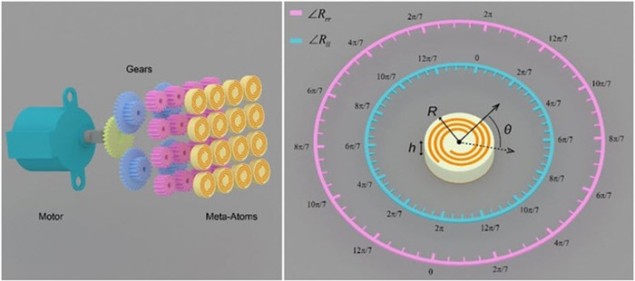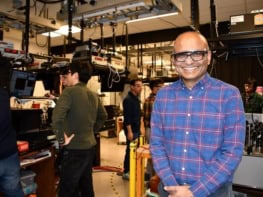
A metasurface that can be reconfigured using electric motors has been designed by researchers in the US and China. The structure can be programmed in real time to control impinging electromagnetic waves and was developed by a team led by Weili Zhang at Oklahoma State University. The metasurface comprises an array of dielectric “meta-atoms”, which can be reoriented in groups. The set-up enabled the team to use the device to perform three very different tasks that involved manipulating microwaves.
Metasurfaces are ultrathin films that comprise arrays of tiny dielectric structures that behave much like atoms – hence they are called meta-atoms. The meta-atoms are separated by distances smaller than the wavelengths of incoming electromagnetic waves. The result is a modification of the amplitude, phase and polarization of incoming wavefronts. This can be used in several different ways to create practical devices.
While some devices use fixed metasurfaces that only perform one function, electrically reconfigurable metasurfaces have also been developed. This usually involves connecting each meta-atom to a diode, creating circuits that consume significant amounts of electrical energy. The result is a design trade-off between the number of meta-atoms in a device, and its overall power requirement – which has hindered the development of large-scale devices.
Rotating meta-atoms
These shortcomings have led researchers to explore the development of mechanically reconfigurable metasurfaces, such as folding devices inspired by origami. Now, Zhang and colleagues have created a metasurface that can be reconfigured by using stepping motors to rotate groups of meta-atoms.

Plasmonic metasurface gives high-speed optical WiFi a boost
The device consists of a 20×20 array of supercells – creating a square surface that is 87 cm on edge. Each supercell contains a 4×4 array of meta-atoms, which are rotated by a stepping motor using connecting gears (see figure). By adjusting the angular orientations of the meta-atoms, the device can be reconfigured to have different effects on impinging microwaves. It can, for example, achieve a continuous and arbitrary control of the phase of microwaves with high efficiency and uniform amplitude. Although stepping motors do consume energy, the requirements of the system are much lower than diode-based systems.
To demonstrate their device, Zhang and colleagues used their metasurface to perform three very different tasks. First, they programmed the device to behave as a metalens, which provides an extremely space-efficient way to focus microwaves. Second, they used it to convert incoming plane waves into vortices with wavefronts that are twisted like a corkscrew around their direction of travel. Finally, they produced a series of holographic images –generating the Chinese characters for “Tianjin University” and “Datong Yungang”, which floated as much as 60 cm above the metasurface.
The researchers hope that their technology could soon be used in a broad range of practical applications. They describe their metasurface in Advanced Photonics.



